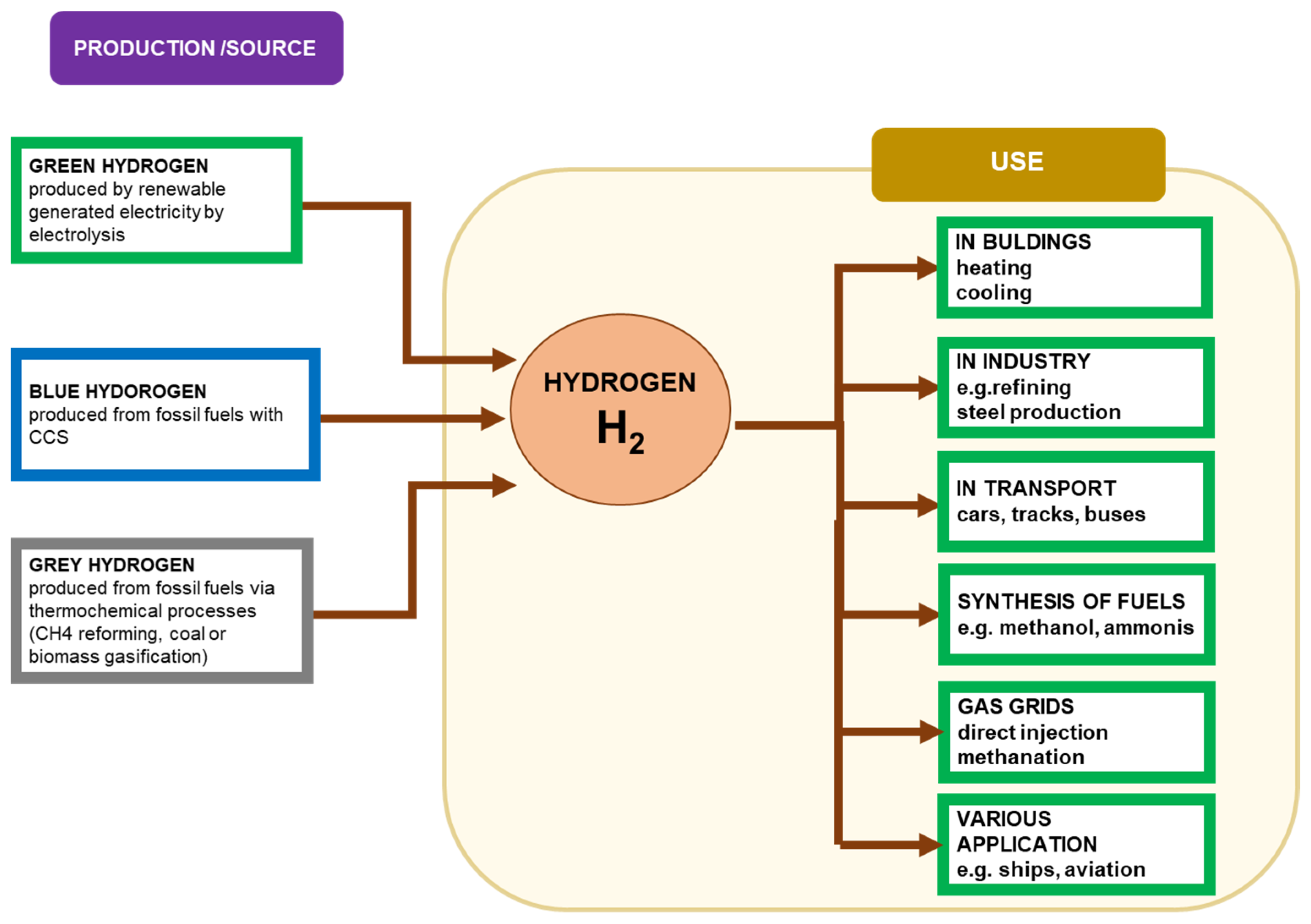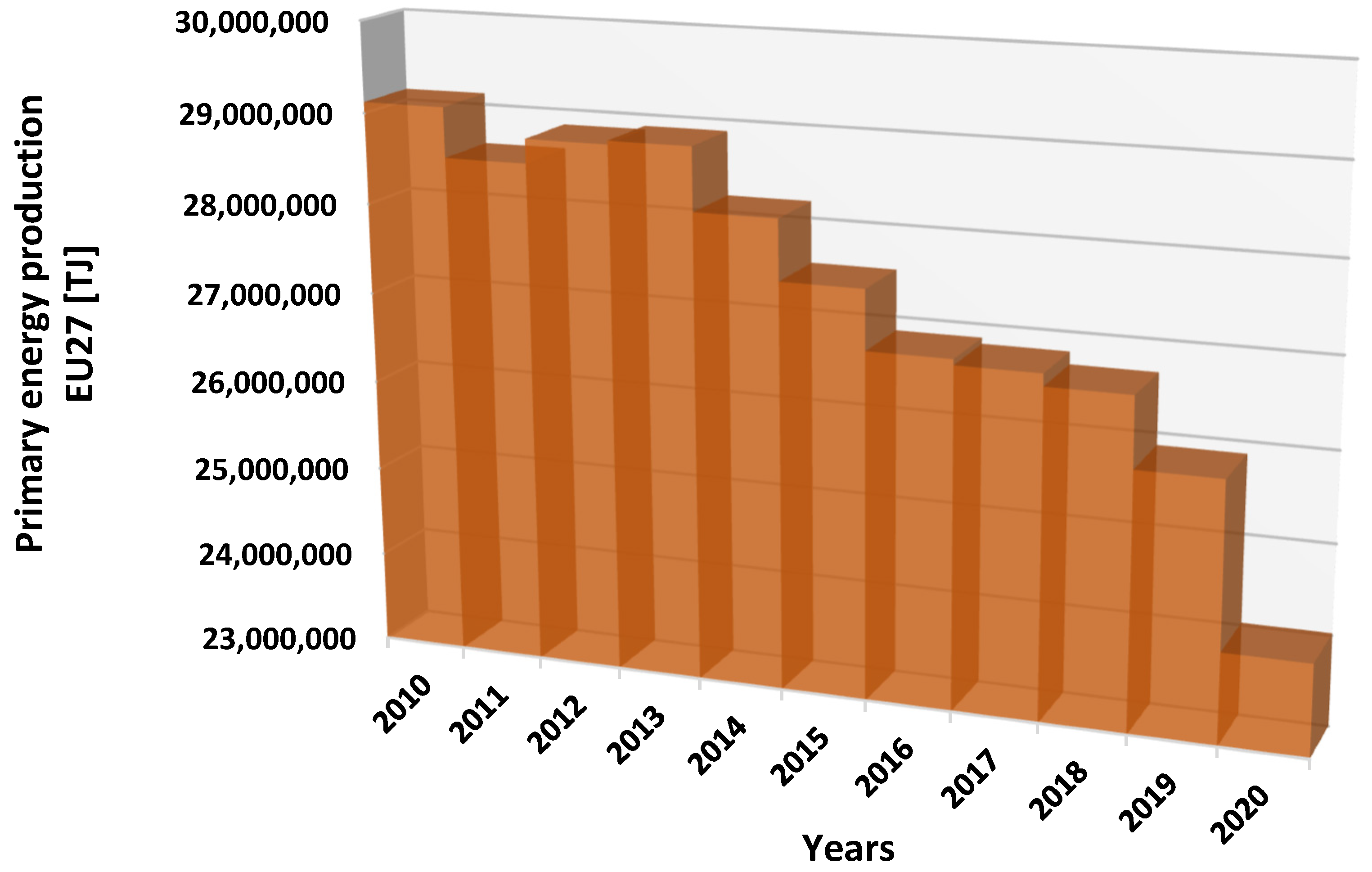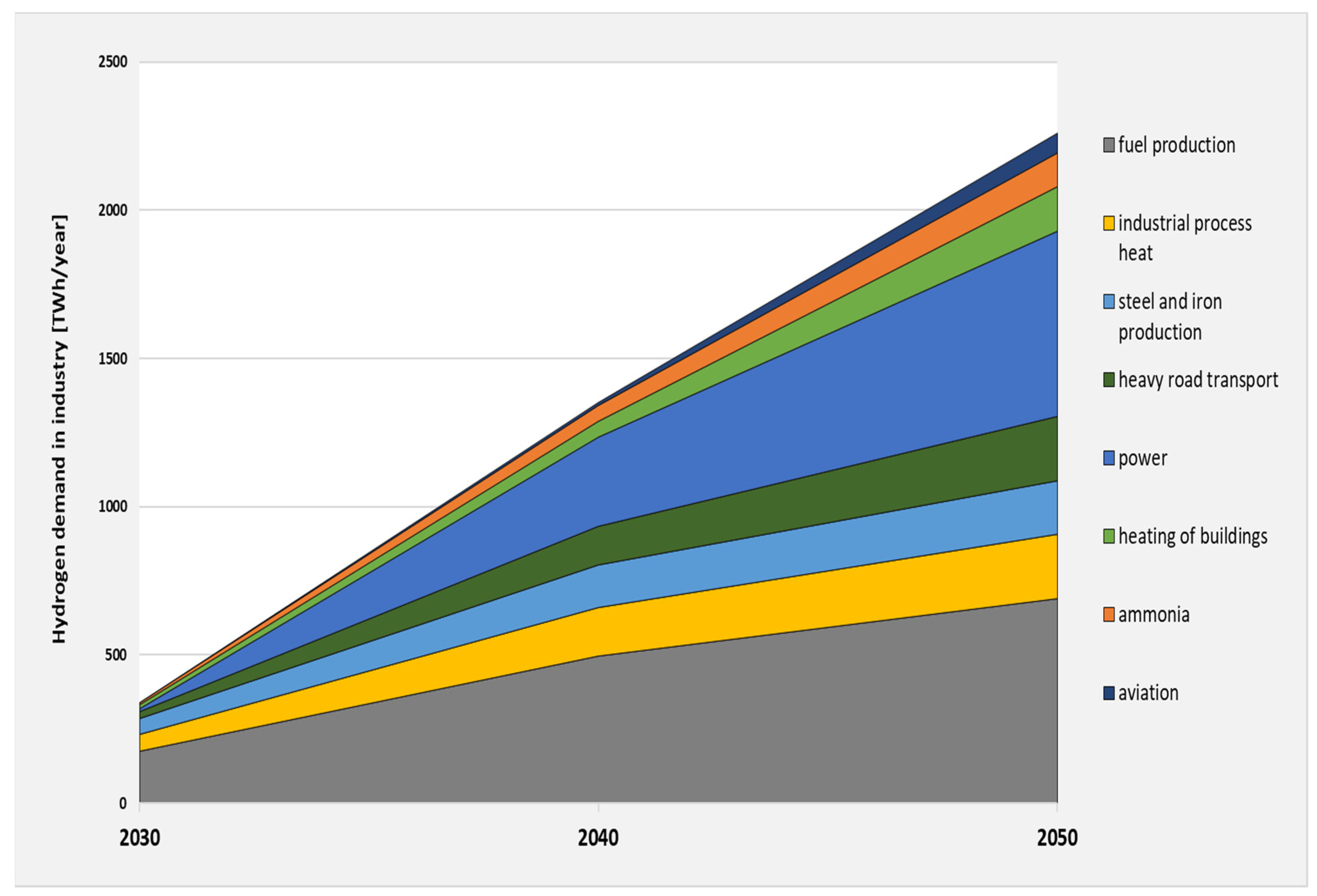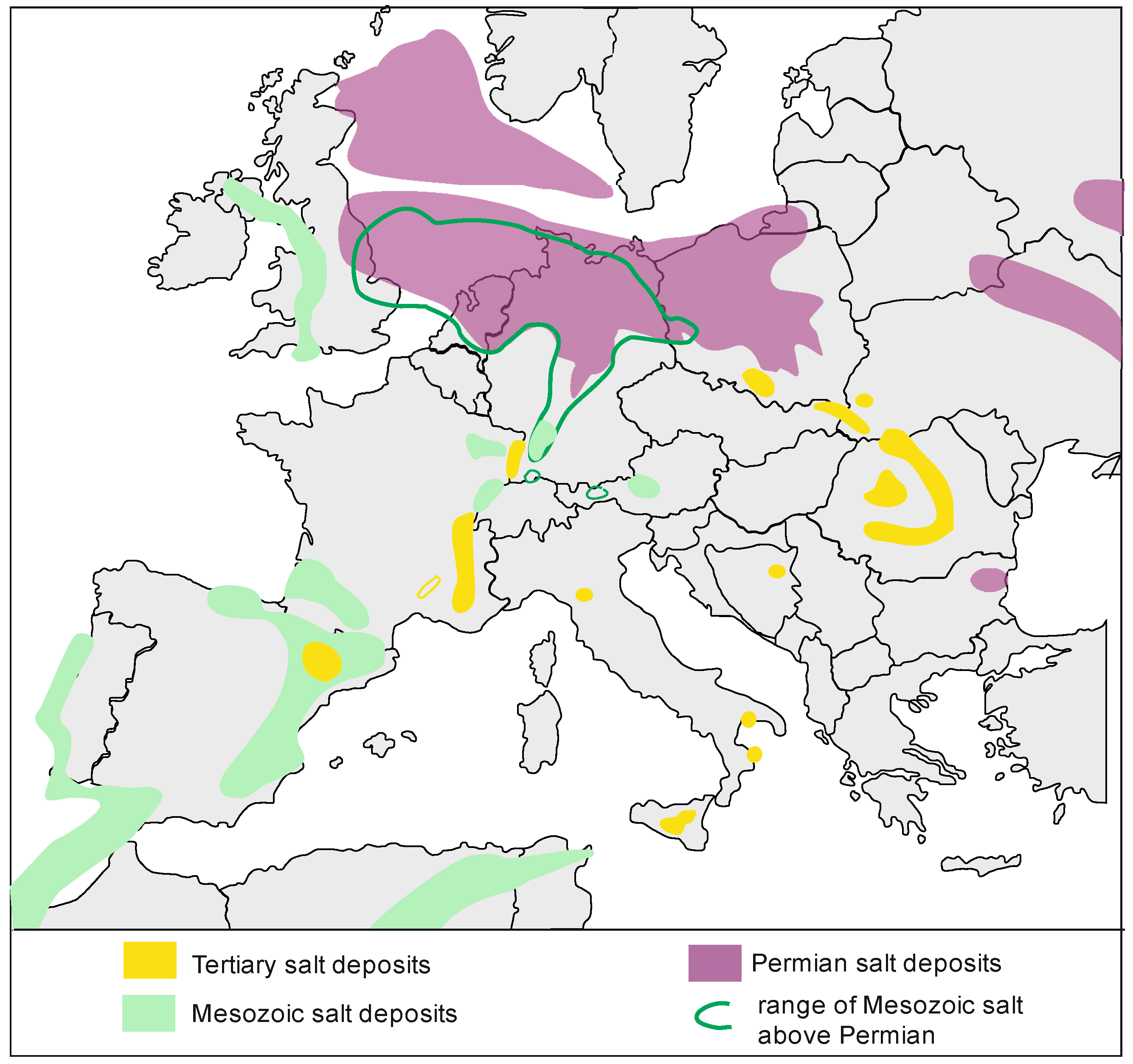Prospects for the Implementation of Underground Hydrogen Storage in the EU
Abstract
1. Introduction
2. EU Policy of Transition to a Low-Emission Economy
- Hydrogen allows for the storage of excess electricity from RES.
- The possibility of supporting seasonal fluctuations in the production of electricity from RES by enabling the connection of production sites with more distant centres of demand [31].
- The need to replace fossil fuels with low-emission energy sources;
- Renewable and low-carbon hydrogen is a key element of the EU’s energy transition by 2050;
- Impact of hydrogen on greater use of renewable energy sources.
3. Forecasts of Energy and Hydrogen Production and Consumption
3.1. Energy Production
- Projected decrease in the consumption of solid fuels;
- Changes in the fuel mix–gradual elimination of fossil fuels in favour of RES;
- Increasing the production of low-emission hydrogen by 2030, replacing it with renewable hydrogen by 2050;
- Increased demand for electricity related to electromobility.
3.2. Increase in Energy Production from Renewable Energy Sources
- Projected significant increase in the share of energy from intermittent RES supplies, which will contribute to increasing the production of renewable hydrogen;
- EU energy transition assuming the decoupling of CO2 emissions from energy consumption.
3.3. Increased Demand for Hydrogen
- Increase in the demand of EU countries for hydrogen from the perspective of 2050, which corresponds to 20–25% of energy consumption;
- Hydrogen is to completely replace natural gas in the chemical, metallurgical, and transport industries by 2050, and in the long term, also in the aviation and maritime sectors;
- Hydrogen provides a solution for those segments of the transport system where emission reductions are difficult to achieve.
4. Increase in Prices of Allowances for Carbon Emissions
- Projected increase in fees for CO2 emissions;
- Development and increase in profitability of CCUS/CCS technology;
- Increased possibilities of industrial use of CO2.
5. Geological Conditions of Underground Hydrogen Storage
- The presence in Europe of large sedimentary basins containing numerous complexes of porous rocks suitable for hydrogen storage;
- Widely distributed and thicker salt-bearing formations suitable for leaching of hydrogen storage caverns.
6. Discussion
7. Conclusions
Author Contributions
Funding
Conflicts of Interest
References
- Abdalla, A.M.; Hossain, S.; Nisfindy, O.B.; Azad, A.T.; Dawood, M.; Azad, A.K. Hydrogen production, storage, transportation and key challenges with applications: A review. Energy Convers. Manag. 2018, 165, 602–627. [Google Scholar] [CrossRef]
- Ball, M.; Weeda, M. The hydrogen economy—Vision or reality? Int. J. Hydrogen Energy 2015, 40, 7903–7919. [Google Scholar] [CrossRef]
- Chapman, A.; Itaoka, K.; Hirose, K.; Davidson, F.T.; Nagasawa, K.; Lloyd, A.C.; Webber, M.E.; Kurban, Z.; Managi, S.; Tamaki, T.; et al. A review of four case studies assessing the potential for hydrogen penetration of the future energy system. Int. J. Hydrogen Energy 2019, 44, 6371–6382. [Google Scholar] [CrossRef]
- Dawood, F.; Anda, M.; Shafiullah, G.M. Hydrogen production for energy: An overview. Int. J. Hydrogen Energy 2020, 45, 3847–3869. [Google Scholar] [CrossRef]
- Elberry, A.M.; Thakur, J.; Santasalo-Aarnio, A.; Larmi, M. Large-scale compressed hydrogen storage as part of renewable electricity storage systems. Int. J. Hydrogen Energy 2021, 46, 15671–15690. [Google Scholar] [CrossRef]
- Hanley, E.S.; Deane, J.P.; Gallachóir, B.P.Ó. The role of hydrogen in low carbon energy futures—A review of existing perspectives. Renew. Sustain. Energy Rev. 2018, 82, 3027–3045. [Google Scholar] [CrossRef]
- Noussan, M.; Raimondi, P.P.; Scita, R.; Hafner, M. The Role of Green and Blue Hydrogen in the Energy Transition—A Technological and Geopolitical Perspective. Sustainability 2021, 13, 298. [Google Scholar] [CrossRef]
- Olabi, A.G.; Bahri, A.S.; Abdelghafar, A.A.; Baroutaji, A.; Sayed, E.T.; Alami, A.H.; Rezk, H.; Abdelkareem, M.A. Large-vscale hydrogen production and storage technologies: Current status and future directions. Int. J. Hydrogen Energy 2021, 46, 23498–23528. [Google Scholar] [CrossRef]
- Sgobbi, A.; Nijs, W.; De Miglio, R.; Chiodi, A.; Gargiulo, M.; Thiel, C. How far away is hydrogen? Its role in the medium and long-term decarbonisation of the European energy system. Int. J. Hydrogen Energy 2016, 41, 19–35. [Google Scholar] [CrossRef]
- Taie, Z.; Villaverde, G.; Speaks Morris, J.; Lavrich, Z.; Chittum, A.; White, K.; Hagen, C. Hydrogen for heat: Using underground hydrogen storage for seasonal energy shifting in northern climates. Int. J. Hydrogen Energy 2021, 46, 3365–3378. [Google Scholar] [CrossRef]
- van Renssen, S. The hydrogen solution? Nat. Clim. Chang. 2020, 10, 799–801. [Google Scholar] [CrossRef]
- Abdin, Z.; Zafaranloo, A.; Rafiee, A.; Mérida, W.; Lipiński, W.; Khalilpour, K.R. Hydrogen as an energy vector. Renew. Sustain. Energy Rev. 2020, 120, 109620. [Google Scholar] [CrossRef]
- Acar, C.; Dincer, I. Review and evaluation of hydrogen production options for better environment. J. Clean. Prod. 2019, 218, 835–849. [Google Scholar] [CrossRef]
- Dominković, D.F.; Bačeković, I.; Pedersen, A.S.; Krajačić, G. The future of transportation in sustainable energy systems: Opportunities and barriers in a clean energy transition. Renew. Sustain. Energy Rev. 2018, 82, 1823–1838. [Google Scholar] [CrossRef]
- Fonseca, J.D.; Camargo, M.; Commenge, J.M.; Falk, L.; Gil, I.D. Trends in design of distributed energy systems using hydrogen as energy vector: A systematic literature review. Int. J. Hydrogen Energy 2019, 44, 9486–9504. [Google Scholar] [CrossRef]
- Ma, J.; Li, Q.; Kühn, M.; Nakaten, N. Power-to-gas based subsurface energy storage: A review. Renew. Sustain. Energy Rev. 2018, 97, 478–496. [Google Scholar] [CrossRef]
- Maggio, G.; Nicita, A.; Squadrito, G. How the hydrogen production from RES could change energy and fuel markets: A review of recent literature. Int. J. Hydrogen Energy 2019, 44, 11371–11384. [Google Scholar] [CrossRef]
- Tarkowski, R. Underground hydrogen storage: Characteristics and prospects. Renew. Sustain. Energy Rev. 2019, 105, 86–94. [Google Scholar] [CrossRef]
- El-Shafie, M.; Kambara, S.; Hayakawa, Y.; El-Shafie, M.; Kambara, S.; Hayakawa, Y. Hydrogen Production Technologies Overview. J. Power Energy Eng. 2019, 7, 107–154. [Google Scholar] [CrossRef]
- European Commission Green Deal. Available online: https://ec.europa.eu/info/strategy/priorities-2019-2024/european-green-deal_en (accessed on 7 September 2022).
- Osman, A.I.; Hefny, M.; Abdel Maksoud, M.I.A.; Elgarahy, A.M.; Rooney, D.W. Recent advances in carbon capture storage and utilisation technologies: A review. Environ. Chem. Lett. 2020, 19, 797–849. [Google Scholar] [CrossRef]
- Blanco, H.; Nijs, W.; Ruf, J.; Faaij, A. Potential for hydrogen and Power-to-Liquid in a low-carbon EU energy system using cost optimization. Appl. Energy 2018, 232, 617–639. [Google Scholar] [CrossRef]
- Hosseini, N.S.; Sobhanardakani, S.; Cheraghi, M.; Lorestani, B.; Merrikhpour, H. Heavy metal concentrations in roadside plants (Achillea wilhelmsii and Cardaria draba) and soils along some highways in Hamedan, west of Iran. Environ. Sci. Pollut. Res. 2020, 27, 13301–13314. [Google Scholar] [CrossRef]
- Abbasi, T.; Abbasi, S.A. ‘Renewable’ hydrogen: Prospects and challenges. Renew. Sustain. Energy Rev. 2011, 15, 3034–3040. [Google Scholar] [CrossRef]
- Andersson, J.; Grönkvist, S. Large-scale storage of hydrogen. Int. J. Hydrogen Energy 2019, 44, 11901–11919. [Google Scholar] [CrossRef]
- Baykara, S.Z. Hydrogen: A brief overview on its sources, production and environmental impact. Int. J. Hydrogen Energy 2018, 43, 10605–10614. [Google Scholar] [CrossRef]
- Cetinkaya, E.; Dincer, I.; Naterer, G.F. Life cycle assessment of various hydrogen production methods. Int. J. Hydrogen Energy 2012, 37, 2071–2080. [Google Scholar] [CrossRef]
- Staffell, I.; Scamman, D.; Velazquez Abad, A.; Balcombe, P.; Dodds, P.E.; Ekins, P.; Shah, N.; Ward, K.R. The role of hydrogen and fuel cells in the global energy system. Energy Environ. Sci. 2019, 12, 463–491. [Google Scholar] [CrossRef]
- Gabrielli, P.; Poluzzi, A.; Kramer, G.J.; Spiers, C.; Mazzotti, M.; Gazzani, M. Seasonal energy storage for zero-emissions multi-energy systems via underground hydrogen storage. Renew. Sustain. Energy Rev. 2020, 121, 109629. [Google Scholar] [CrossRef]
- Nowotny, J.; Veziroglu, T.N. Impact of hydrogen on the environment. Int. J. Hydrogen Energy 2011, 36, 13218–13224. [Google Scholar] [CrossRef]
- COM/2020/301; Communication from the Commission to the European Parliament, the Council, the European Economic and Social Committee and the Committee of the Regions—A hydrogen strategy for a climate-neutral Europe. European Commission: Brussels, Belgium, 2020.
- Maeder, M.; Weiss, O.; Boulouchos, K. Assessing the need for flexibility technologies in decarbonized power systems: A new model applied to Central Europe. Appl. Energy 2021, 282, 116050. [Google Scholar] [CrossRef]
- McPherson, M.; Johnson, N.; Strubegger, M. The role of electricity storage and hydrogen technologies in enabling global low-carbon energy transitions. Appl. Energy 2018, 216, 649–661. [Google Scholar] [CrossRef]
- Wang, A.; Jens, J.; Mavins, D.; Moultak, M.; Schimmel, M.; Van Der Leun, K.; Peters, D.; Buseman, M. Analysing future demand, supply, and transport of hydrogen. In European Hydrogen Backbone Executive Summary; European Hydrogen Backbone: Online, 2021. [Google Scholar]
- Mitrova, T.; Melnikov, Y.; Chugunov, D. The Hydrogen Economy—A path towards low carbon development; Moscow School of Management SKOLKOVO: Moscow, Russia, 2019. [Google Scholar]
- Amez Arenillas, I.; Ortega, M.F.; García Torrent, J.; Llamas Moya, B. Hydrogen as an Energy Vector: Present and Future. In Sustaining Tomorrow via Innovative Engineering; World Scientific: Singapore, 2021; pp. 83–129. [Google Scholar]
- Melaina, M.W.; Antonia, O.; Penev, M. Blending Hydrogen into Natural Gas Pipeline Networks: A Review of Key Issues; National Renewable Energy Laboratory: Golden, CO, USA, 2013. [Google Scholar]
- Shi, Z.; Jessen, K.; Tsotsis, T.T. Impacts of the subsurface storage of natural gas and hydrogen mixtures. Int. J. Hydrogen Energy 2020, 45, 8757–8773. [Google Scholar] [CrossRef]
- Crotogino, F.; Schneider, G.-S.; Evans, D.J. Renewable energy storage in geological formations. J. Power Energy 2018, 232, 100–114. [Google Scholar] [CrossRef]
- Tarkowski, R. Perspectives of using the geological subsurface for hydrogen storage in Poland. Int. J. Hydrogen Energy 2017, 42, 347–355. [Google Scholar] [CrossRef]
- Tarkowski, R.; Uliasz-Misiak, B.; Tarkowski, P. Storage of hydrogen, natural gas, and carbon dioxide—Geological and legal conditions. Int. J. Hydrogen Energy 2021, 46, 20010–20022. [Google Scholar] [CrossRef]
- Taylor, J.B.; Alderson, J.E.A.; Kalyanam, K.M.; Lyle, A.B.; Phillips, L.A. Technical and economic assessment of methods for the storage of large quantities of hydrogen. Int. J. Hydrogen Energy 1986, 11, 5–22. [Google Scholar] [CrossRef]
- Zivar, D.; Kumar, S.; Foroozesh, J. Underground hydrogen storage: A comprehensive review. Int. J. Hydrogen Energy 2021, 46, 23436–23462. [Google Scholar] [CrossRef]
- Heinemann, N.; Booth, M.G.; Haszeldine, R.S.; Wilkinson, M.; Scafidi, J.; Edlmann, K. Hydrogen storage in porous geological formations—Onshore play opportunities in the midland valley (Scotland, UK). Int. J. Hydrogen Energy 2018, 43, 20861–20874. [Google Scholar] [CrossRef]
- Lankof, L.; Tarkowski, R. Assessment of the potential for underground hydrogen storage in bedded salt formation. Int. J. Hydrogen Energy 2020, 45, 19479–19492. [Google Scholar] [CrossRef]
- Liebscher, A.; Wackerl, J.; Streibel, M. Geologic Storage of Hydrogen—Fundamentals, Processing, and Projects. In Hydrogen Science and Engineering: Materials, Processes, Systems and Technology; Stolten, D., Emonts, B., Eds.; John Wiley & Sons, Ltd.: Hoboken, NJ, USA, 2016; Volume 2, pp. 629–658. [Google Scholar]
- Garcia, D.A.; Barbanera, F.; Cumo, F.; Matteo, U. Di; Nastasi, B. Expert Opinion Analysis on Renewable Hydrogen Storage Systems Potential in Europe. Energies 2016, 9, 963. [Google Scholar] [CrossRef]
- Heinemann, N.; Alcalde, J.; Miocic, J.M.; Hangx, S.J.T.; Kallmeyer, J.; Ostertag-Henning, C.; Hassanpouryouzband, A.; Thaysen, E.M.; Strobel, G.J.; Schmidt-Hattenberger, C.; et al. Enabling large-scale hydrogen storage in porous media—The scientific challenges. Energy Environ. Sci. 2021, 14, 853–864. [Google Scholar] [CrossRef]
- Lankof, L.; Urbańczyk, K.; Tarkowski, R. Assessment of the potential for underground hydrogen storage in salt domes. Renew. Sustain. Energy Rev. 2022, 160, 112309. [Google Scholar] [CrossRef]
- Hache, E.; Palle, A. Renewable energy source integration into power networks, research trends and policy implications: A bibliometric and research actors survey analysis. Energy Policy 2019, 124, 23–35. [Google Scholar] [CrossRef]
- Tarkowski, R.; Uliasz-Misiak, B. Towards underground hydrogen storage: A review of barriers. Renew. Sustain. Energy Rev. 2022, 162, 112451. [Google Scholar] [CrossRef]
- European Commission. A Clean Planet for All A European Strategic Long-Term Vision for a Prosperous, Modern, Competitive and Climate Neutral Economy; European Commission: Brussels, Belgium, 2018; pp. 1–25. [Google Scholar]
- COM/2019/640; Communication from the Commission—The European Green Deal. European Commission: Brussels, Belgium, 2019.
- COM/2020/299; Communication from the Commission to the European Parliament, the Council, the European Economic and Social Committee and the Committee of the Regions—Powering a Climate-Neutral Economy: An EU Strategy for Energy System Integration. European Commission: Brussels, Belgium, 2020.
- European Commission REPowerEU: Affordable, Secure and Sustainable Energy for Europe. Available online: https://ec.europa.eu/info/strategy/priorities-2019-2024/european-green-deal/repowereu-affordable-secure-and-sustainable-energy-europe_en (accessed on 14 September 2022).
- EUROSTAT Primary Energy Production. Available online: https://ec.europa.eu/eurostat/statistics-explained/index.php?title=Energy_production_and_imports/pl (accessed on 7 September 2022).
- European Commission. EU Energy in Figures—Statisticals Pockebook; European Commission: Luxembourg, 2022. [Google Scholar]
- Quarton, C.J.; Samsatli, S. Power-to-gas for injection into the gas grid: What can we learn from real-life projects, economic assessments and systems modelling? Renew. Sustain. Energy Rev. 2018, 98, 302–316. [Google Scholar] [CrossRef]
- Tagliapietra, S.; Zachmann, G.; Edenhofer, O.; Glachant, J.M.; Linares, P.; Loeschel, A. The European union energy transition: Key priorities for the next five years. Energy Policy 2019, 132, 950–954. [Google Scholar] [CrossRef]
- Matos, C.R.; Carneiro, J.F.; Silva, P.P. Overview of Large-Scale Underground Energy Storage Technologies for Integration of Renewable Energies and Criteria for Reservoir Identification. J. Energy Storage 2019, 21, 241–258. [Google Scholar] [CrossRef]
- IRENA. Renewable Energy Prospects for the European Union; IRENA: Abu Dhabi, United Arab Emirates, 2018. [Google Scholar]
- Mantzos, L.; Wiesenthal, T.; Neuwahl, F.; Rózsai, M. The POTEnCIA. Central Scenario. An EU Energy Outlook to 2050, EUR 29881 EN; European Commission: Luxembourg, 2019. [Google Scholar]
- Hosseini, S.E.; Wahid, M.A. Hydrogen production from renewable and sustainable energy resources: Promising green energy carrier for clean development. Renew. Sustain. Energy Rev. 2016, 57, 850–866. [Google Scholar] [CrossRef]
- IEA. The Future of Hydrogen Executive Summary and Recommendations; IEA: Paris, France, 2019. [Google Scholar]
- IEA. Hydrogen; IEA: Paris, France, 2022. [Google Scholar]
- Allsop, A.; Bortolotti, M. Clean Hydrogen Monitor; Hydrogen Europe: Brussels, Belgium, 2022. [Google Scholar]
- World Energy Council. Hydrogen-Industry as Catalyst The Netherlands Accelerating the Decarbonisation of Our Economy to 2030; World Energy Council: London, UK, 2018. [Google Scholar]
- Hydrogen Council. New Opportunities for the Energy and Mobility System; Hydrogen Council: Brussels, Belgium, 2018. [Google Scholar]
- European Court of Auditors. Special Repoert—The EU’s Emissions Trading System: Free Allocation of Allowances Needed Better Targeting; European Court of Auditors: Luxembourg, 2020. [Google Scholar]
- Stiglitz, J.E.; Stern, N.; Duan, M.; Edenhofer, O.; Giraud, G.; Heal, G.M.; la Rovere, E.L.; Morris, A.; Moyer, E.; Pangestu, M.; et al. Report of the High-Level Commission on Carbon Prices; International Bank for Reconstruction and Development and International Development Association/The World Bank: Washington, DC, USA, 2017. [Google Scholar]
- Pyrka, M.; Tobiasz, I.; Boratyński, J.; Jeszke, R.; Mzyk, P. The European Green Deal Impact on the GHG’s Emission Reduction Target for 2030 and on the EUA Prices; KOBIZE: Warsaw, Poland, 2020. (In Polish) [Google Scholar]
- EMBER EU Carbon Price Tracker. Available online: https://ember-climate.org/data/data-tools/carbon-price-viewer/ (accessed on 15 September 2022).
- Portarapillo, M.; Di Benedetto, A. Risk Assessment of the Large-Scale Hydrogen Storage in Salt Caverns. Energies 2021, 14, 2856. [Google Scholar] [CrossRef]
- Ebigbo, A.; Golfier, F.; Quintard, M. A coupled, pore-scale model for methanogenic microbial activity in underground hydrogen storage. Adv. Water Resour. 2013, 61, 74–85. [Google Scholar] [CrossRef]
- Bai, M.; Song, K.; Sun, Y.; He, M.; Li, Y.; Sun, J. An overview of hydrogen underground storage technology and prospects in China. J. Pet. Sci. Eng. 2014, 124, 132–136. [Google Scholar] [CrossRef]
- Kruck, O.; Crotogino, F.; Prelicz, R.; Rudolph, T. A Overview on all Known Underground Storage Technologies for Hydrogen; 2013; Available online: http://hyunder.eu/wp-content/uploads/2016/01/D3.1_Overview-of-all-known-underground-storage-technologies.pdf (accessed on 15 September 2022).
- Hévin, G. Underground storage of Hydrogen in salt caverns. In Proceedings of the European Workshop on Underground Energy Storage, Paris, France, 7–8 November 2019. [Google Scholar]
- Kruck, O.; Crotogino, F. Benchmarking of Selected Storage Options—“HyUnder” Project; European Commission: Brussels, Belgium, 2013. [Google Scholar]
- Panfilov, M. Underground and pipeline hydrogen storage. In Compendium of Hydrogen Energy; Elsevier: Amsterdam, The Netherlands, 2016; Volume 2, pp. 91–115. [Google Scholar]
- Ponomarev-Stepnoy, N.N.; Stolyarevsky, A.Y. Major aspects of strategy of hydrogen-base power development with nuclear energy sources. In Proceedings of the International Conference on Fifty Years of Nuclear Power—The Next Fifty Years, Moscow, Russia, 27 June–2 July 2004; International Atomic Energy Agency: Vienna, Austria, 2004. [Google Scholar]
- Basniev, K.S.; Omelchenko, R.; Adzynova, F.A. Underground Hydrogen Storage Problems in Russia. In Proceedings of the WHEC, Essen, Germany, 17–19 May 2010; Stolten, D., Grube, T., Eds.; Forschungszentrum Jülich GmbH, Zentralbibliothek, Verlag: Essen, Germany, 2010; pp. 47–53. [Google Scholar]
- Panfilov, M. Underground Storage of Hydrogen: In Situ Self-Organisation and Methane Generation. Transp. Porous Media 2010, 85, 841–865. [Google Scholar] [CrossRef]
- Stolten, D.; Emonts, B. (Eds.) Hydrogen Science and Engineering: Materials, Processes, Systems and Technology; Wiley-VCH Verlag: Weinheim, Germany, 2016; Volume 1–2. [Google Scholar]
- Carden, P.O.; Paterson, L. Physical, chemical and energy aspects of underground hydrogen storage. Int. J. Hydrogen Energy 1979, 4, 559–569. [Google Scholar] [CrossRef]
- Garlicki, A. Salt Mines in the World. In Wieliczka; Universitas: Krakow, Poland, 2013; pp. 11–30. [Google Scholar]
- Blanco, H.; Faaij, A. A review at the role of storage in energy systems with a focus on Power to Gas and long-term storage. Renew. Sustain. Energy Rev. 2018, 81, 1049–1086. [Google Scholar] [CrossRef]
- Rütters, H.; Partners, C.E. State of Play on CO2 Geological Storage in 28 European Countries; European Commission: Brussels, Belgium, 2013. [Google Scholar]
- Rütters, H.; Möller, I.; May, F.; Flornes, K.; Hladik, V.; Arvanitis, A.; Gülec, N.; Bakiler, C.; Dudu, A.; Kucharic, L.; et al. State-of-the-Art of Monitoring Methods to Evaluate CO2 Storage Site Performance; CGS Europe: Brussels, Belgium, 2013. [Google Scholar]









Publisher’s Note: MDPI stays neutral with regard to jurisdictional claims in published maps and institutional affiliations. |
© 2022 by the authors. Licensee MDPI, Basel, Switzerland. This article is an open access article distributed under the terms and conditions of the Creative Commons Attribution (CC BY) license (https://creativecommons.org/licenses/by/4.0/).
Share and Cite
Uliasz-Misiak, B.; Lewandowska-Śmierzchalska, J.; Matuła, R.; Tarkowski, R. Prospects for the Implementation of Underground Hydrogen Storage in the EU. Energies 2022, 15, 9535. https://doi.org/10.3390/en15249535
Uliasz-Misiak B, Lewandowska-Śmierzchalska J, Matuła R, Tarkowski R. Prospects for the Implementation of Underground Hydrogen Storage in the EU. Energies. 2022; 15(24):9535. https://doi.org/10.3390/en15249535
Chicago/Turabian StyleUliasz-Misiak, Barbara, Joanna Lewandowska-Śmierzchalska, Rafał Matuła, and Radosław Tarkowski. 2022. "Prospects for the Implementation of Underground Hydrogen Storage in the EU" Energies 15, no. 24: 9535. https://doi.org/10.3390/en15249535
APA StyleUliasz-Misiak, B., Lewandowska-Śmierzchalska, J., Matuła, R., & Tarkowski, R. (2022). Prospects for the Implementation of Underground Hydrogen Storage in the EU. Energies, 15(24), 9535. https://doi.org/10.3390/en15249535






